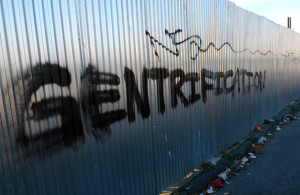There’s a trend that’s been happening for a long, long time, where comparably wealthy people chase around poor people and kick them out of their living spaces. We now use the term “gentrification” to describe this social and economic phenomenon.
Back in the old days, before FDR had the sprawling U.S. highway system built on the cheap by desperate folks who lost their jobs in the Great Depression, people wanted to live close to their work. And since factories were built largely in the major cities – or else major cities popped up around the factories – that’s where workers lived. People with money were drawn to city centers and the poor were left in shanty-towns and hovels on the fringes of the urban metropolises.
Metropolises? Metropoles? Metropoli? I don’t know.
But, anyway, it sucked to be in the ‘burbs. As a consequence, the property values were really low. So, when the highways magically appeared and everybody hopped into cars, the comparably wealthy folks said, “Hey, let’s get away from the ugly city and buy up some of this cheap property away from the smog and exhaust.” Since they had the means to commute to work , they thought it would be awesome to scarf up the living spaces of the desperately poor on the fringes.
Developers come in. Boom. The suburbs.
Condominiums. Strip malls. McDonalds. Starbucks.
Life was grand for the comparably wealthy, but the desparate poor couldn’t afford to rent the condo or to drink the latte-whatever-whatever at Starbucks. So, being displaced, the poor migrated into the city spaces vacated by the upwardly and outwardly-mobile. They took the hand-me-downs in the inner city.
So what we essentially had was a city-center that was a ghetto, plagued with poverty, unemployment, crime, drugs and a variety of social ills, and the poor were essentially held there in a kind of prison formed by the ring of high property values that held them in.
We fast forward to today, and we have the same process at work, only in reverse. We’re putting benevolent names on it, words like “urban renewal,” or “re-investment,” but the process is the same: the comparably wealthy see areas where property values are depressed, so they begin buying up “islands” of renovation, islands that receive more protection by the police. These islands are off limits to the poor and largely black city population while attracting a migration of more-wealthy whites. Again just like previous, historical instances of the poor being displaced, the influx of these suburbanites raises the property values and drives the poor from the area.
Gentrification.
So, how do we effectively oppose it?
My first reaction, in the simple answer, is that we have to refrain from participating in the gentrification process. But what does that mean? Does that mean we just don’t move into a new area and pay high rent that others cannot afford? That might be like a mandatory minimum requirement, I guess. But it seems to me that to effectively oppose gentrification, we have to identify all of the profiteers who are gaining from gentrification, from the landlords to the corporate coffee shops. And once we identify them, we have to develop strategies for sabotaging their profits.
That’s what it boils down to, right? Because gentrification is driven by profit margins.
So, in developing an anti-GENTRIFICATION strategy, we have to develop an anti-PROFIT strategy. We have to ask ourselves: if I were a slumlord or Starbucks or McDonalds, what would be the events that would drive me out of this neighborhood? What would force me to abandon my profit plans?
And then do that.
Some forms of resistance might be extreme single events that really rock the gentrifiers, while other forms of resistance are long-term, sustained actions. For stuff like that, you’d almost have to mobilize and inspire the local populace to take up the cause for themselves.
You’d almost have to be able to articulate a vision of how the folks getting gentrified could and should resist, connecting the dots between the profiteers and the rising rent prices that drive them into a new round of migration. Then, perhaps, those long term, sustained rebellions will occur seemingly on their own.
One interesting idea would be to locate where the gentrifiers themselves live… and follow THEM home to THEIR neighborhoods… and impact the property values where THEY live.
Just an idea.
As I like to point out quite frequently, gaosoline is cheap and matches are free.
This is anarchist prisoner Sean Swain being silenced by prison officials somewhere in the Ohio Prison torture complex.
If you’re listening, you ARE the resistance.
http://www.ashevillefm.org/the-final-straw
